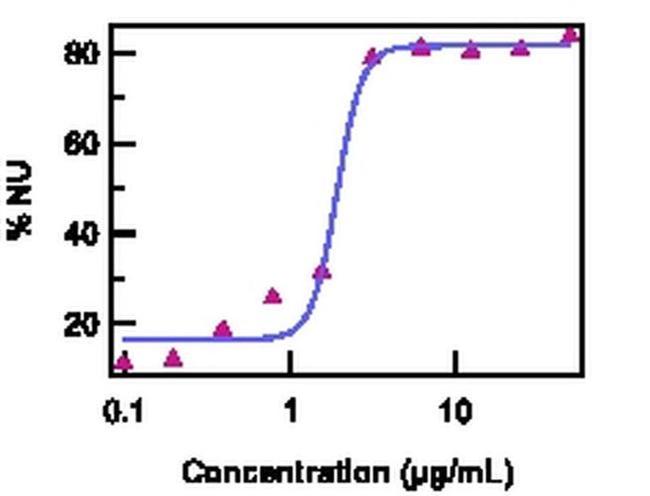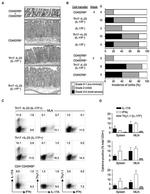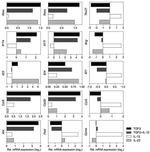Search Thermo Fisher Scientific
Invitrogen
IL-17F Monoclonal Antibody (SHLR17), Functional Grade, eBioscience™
Product Details
16-7169-82
Species Reactivity
Published species
Host/Isotype
Recommended Isotype Control
Class
Type
Clone
Conjugate
Form
Concentration
Purification
Storage buffer
Contains
Storage conditions
Shipping conditions
RRID
Product Specific Information
Description: This SHLR17 monoclonal antibody reacts with human interleukin (IL)-17F. IL-17F is a homodimeric, 34 kDa member of the IL-17 family, which includes IL-17(A), B, C, D, E (IL-25). Within this family, IL-17A and IL-17F are produced preferentially by T helper 17 (Th17) cells, with other members produced more widely. IL-17F and IL-17A have many overlapping functions, but knockout studies have shown each to have independent functions as well. In vitro cultured Th17 cells have been shown to express IL-17F and IL-17A homodimers and IL-17A/F heterodimers depending on the culture conditions and their differentiation state. A heterodimer of IL-17RA and IL-17RC has been shown to bind IL-17F, resulting in target cell-secretion of pro-inflammatory cytokines and chemokines, as well as neutrophil recruitment.
This SHLR17 monoclonal antibody neutralizes the bioactivity of IL-17F homodimers without affecting IL-17A/F heterodimers.
Applications Reported: This SHLR17 monoclonal antibody inhibits the activity of human IL-17F.
Applications Tested: The ND50 of SHLR17, as measured by the inhibition of mouse IL-6 induction in NIH/3T3 cells, is 0.5-4 µg/mL in the presence of 1 µg/mL of Human IL-17F Recombinant Protein. Neutralization dose will vary depending on assay method, cytokine concentration, and cell type. This antibody should be carefully titrated for optimal performance in the assay of interest.
Storage and handling: Use in a sterile environment.
Filtration: 0.2 µm post-manufacturing filtered.
Purity: Greater than 90%, as determined by SDS-PAGE.
Endotoxin Level: Less than 0.001 ng/µg antibody, as determined by LAL assay.
Aggregation: Less than 10%, as determined by HPLC.
Target Information
IL-17F (Interleukin 17F, CTLA-8)) is a cytokine belonging to the IL-17 family that is produced by inflammatory cells such as activated T cells, mast cells, and basophils. IL-17F is involved in allergic airway inflammation, and can induce several cytokines, chemokines, and adhesion molecules in bronchial epithelial cells, vein endothelial cells, fibroblasts, and eosinophils. IL-17F may be secreted as a homodimer, or a heterodimer with IL17A. It acts by binding to the type I receptor, IL-17R, aiding recruitment of monocytes and neutrophils at the site of inflammation by increasing chemokine production. IL-17F also stimulates induction of other pro-inflammatory cytokines TNF alpha, IL-1 beta, IL-6, and IL-8, and reports strongly suggest the involvement of IL-17 in several chronic inflammatory diseases such as rheumatoid arthritis, psoriasis and multiple sclerosis. TGF-beta (differentiation) and IL-23 (expansion) are required for induction and maintenance of Th17 (IL-17 producing) cells, which in turn induce the other pro-inflammatory cytokines. IL-17F is produced, and exists, as a homo-dimer, with homology to a herpes virus early protein, is one of the six members (IL-17A-F) of this cytokine family, and is well characterized and highly expressed by activated effector memory T cells. IL-17F has been found to inhibit the angiogenesis of endothelial cells and induce endothelial cells to produce IL2, TGFB1/TGFB, and monocyte chemoattractant protein-1.
For Research Use Only. Not for use in diagnostic procedures. Not for resale without express authorization.
Bioinformatics
Protein Aliases: Cytokine ML-1; IL-17F; ILN; Interleukin; Interleukin-17F; interleukin-24; Interleukin17F; mutant IL-17F
Gene Aliases: CANDF6; IL-17F; IL17F; ML-1; ML1
UniProt ID: (Human) Q96PD4
Entrez Gene ID: (Human) 112744

Performance Guarantee
If an Invitrogen™ antibody doesn't perform as described on our website or datasheet,we'll replace the product at no cost to you, or provide you with a credit for a future purchase.*
Learn more
We're here to help
Get expert recommendations for common problems or connect directly with an on staff expert for technical assistance related to applications, equipment and general product use.
Contact tech support



